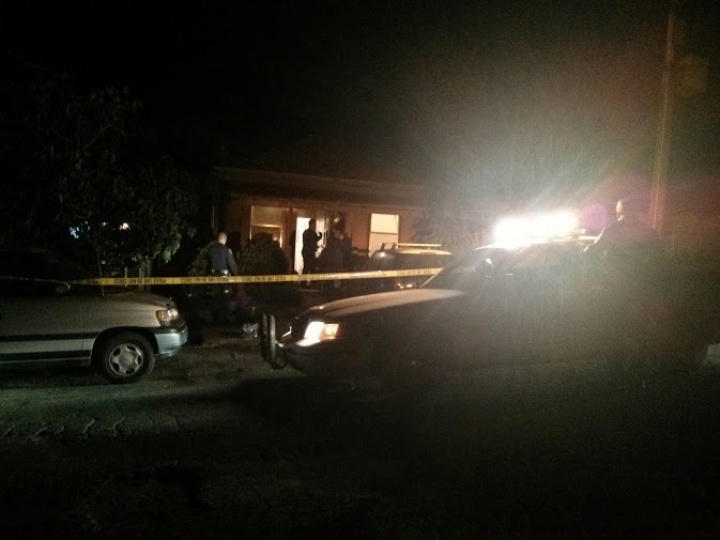
The scene of the shooting of Trevor Harrison on the night of May 9, 2015. Photo: Diover Duario.
PREVIOUSLY:
- Giddings-Huntinger Trial, Day One
- Giddings-Huntzinter Trial, Day Two
- Giddings-Huntzinger Trial, Day Three
- Giddings-Huntzinger Trial, Day Four
- Giddings-Huntzinger Trial, Day Five
It was just one small-caliber bullet, but it went straight through Trevor Mark Harrison’s heart.

Huntzinger and Giddings
The bullet that killed Harrison also perforated his left lung and liver, forensic pathologist Dr. Mark Super testified today during the murder trial of Billy Joe Giddings and Robert Louis Huntzinger. Super performed an autopsy on Harrison on May 16, 2015, one week after Giddings allegedly shot him during a marijuana transaction at the Arcata home of Harrison’s mother.
The trial is wrapping up, with Judge Dale Reinholtsen telling jurors they have now heard “the bulk of the evidence.” The trial will not be in session Friday, and testimony should finish Monday or Tuesday. The jury will then hear instructions on the law, and attorneys will present closing arguments.
Today jurors were shown a photo of the bullet’s one-third-inch entry wound, which was on Harrison’s upper back below his left shoulder. They also saw a photograph of the slain man’s exposed internal organs, with a metal rod inserted in the bullet hole and following the bullet’s downward path.
Super testified he found the bullet lodged just below Harrison’s liver. He had no other injuries except a bruise on his upper right thigh just above the knee.
Harrison had methamphetamine in his bloodstream, Super said. Toxic levels of meth range from 0.2 to 5 milligrams per liter, and Harrison’s level was at 0.98. Or as Giddings’ attorney Luke Brownfield pointed out, about five times higher than the lowest level considered toxic.
But Super, under questioning by Deputy District Attorney Roger Rees, said it’s impossible to say how a person with that amount of meth in his system would have been behaving.
“Any medication that’s taken chronically,” he said, “they may have a high level in their blood and be acting normally.”
Brownfield said during his opening statement that Harrison was high on meth, and that Giddings shot him only because he was pointing a gun at him. So far all witnesses have testified that Harrison had no gun. They said he was just trying to stop Huntzinger from forcing his way in the kitchen door as Giddings held people at gunpoint in the living room.
No other chemicals were detected in Harrison’s body, though he reportedly told his mother he had taken Klonopin that day. She thought he was acting “kind of slow.”
Although Harrison was shot in the back, Super said he believes he was facing the shooter, or at least the barrel of the gun, when he was hit. Judging by the path of the bullet, he was probably bending over from the waist. Super said it’s possible he could have been standing with his left shoulder facing the shooter, “but he’d have to be stooped.”
Super saw no gunshot residue on Harrison’s hands. And chemical tests for gunshot residue are now “in disfavor,” he said, because they are not considered accurate. He said that would be especially true when the autopsy was done a week after the incident.
Harrison lived in the Sunny Brae area and was just visiting his mother Kay Haug the night he was killed. At that time Haug was buying and selling marijuana. A marijuana broker named Kimberly Steele had been at her Eastern Avenue home three times that day. The first two times Steele was with Huntzinger, who was trying to sell Haug some pot. Both times Haug didn’t want what he had to offer.
On the third and final visit Steele showed up with Giddings, who reportedly pulled a gun within seconds and demanded Haug’s purse. Witnesses have said Giddings warned Harrison to get away from the door, which he was trying to keep closed on Huntzinger.
There was a bullet hole in that door, possibly from a bullet that missed.
So far the jury has not heard from Kimberly Steele, whose name has been prominent during trial testimony. She was arrested but quickly released and never charged.
For Giddings, the issue is whether he shot Harrison because he was pointing a gun at him. Haug has acknowledged she kept a gun in her bedroom for protection, but she is adamant her son had no gun in his hands when he was shot.
Haug’s friend and caregiver Demian Starlight did hide the gun afterward, along with about 20 pounds of packaged marijuana. But Haug and Starlight both testified the gun was hidden only because it was unregistered and belonged to Starlight’s mother.
After Harrison was shot and collapsed on the floor, Huntzinger reportedly came into the house carrying a duffel bag and a crowbar. He went into a back room and emerged a few minutes later, reportedly with the bag looking fuller.
Haug testified that the only item missing from her bedroom was some marijuana “kief.” Many pounds of marijuana, stashed in various containers, were left behind. Also untouched was several thousand dollars kept in a variety of bags.
Did Huntzinger know that Giddings allegedly planned a robbery? If so, even though he never pulled the trigger, jurors could convict him of murder because someone was killed during the process.
CLICK TO MANAGE